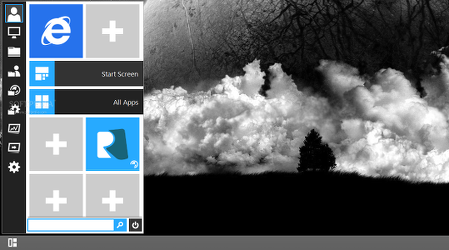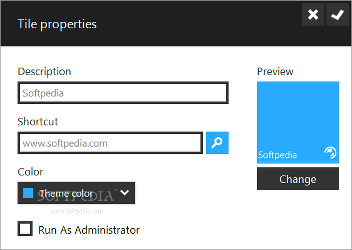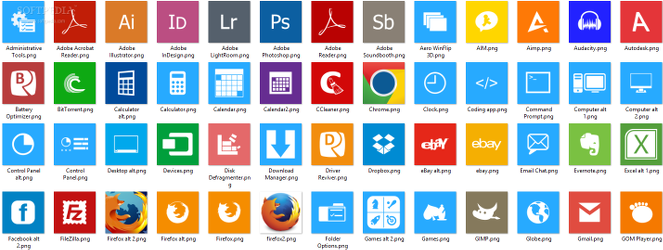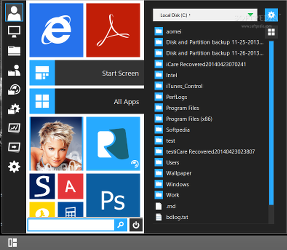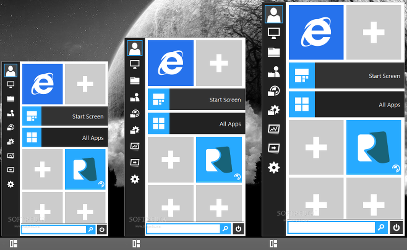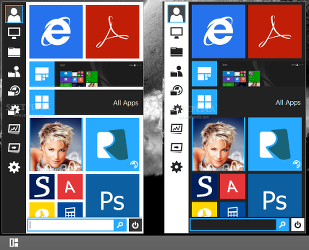As we already know, Microsoft has announced Start Menu's return in a future Windows iteration, whether it's Windows 8.2 or Windows 9. Ever since the company has stripped the OS of the beloved Start Menu, third-party developers have stepped in with their own concepts, and most of them were based on the classic look of Windows 7 and XP.
Start Menu Reviver is an exception to that rule. Initially designed by Jay Machalani, its fresh concept has finally become a reality, courtesy of developer ReviverSoft. It seems that Microsoft itself may have borrowed some ideas from it for the official upcoming Start Menu.
Reviver's newly released edition envisions a blend of the old Windows and new one, trying to bring out the best features from both worlds, pre- and post-Start menu. The package includes smooth animations ripped from the Start Screen, shortcuts to desktop and modern apps, a search function similar to the one of Windows 7, custom tiles for launching programs and websites, as well as the obligatory appearance customization settings.
Reviver installs seamlessly and quickly. It does not automatically replace the Start Screen button in Windows 8.1 (or Start Screen thumbnail in Windows 8), but creates a secondary button for the Start Menu instead. The Start Screen may still be activated by moving the mouse cursor to the bottom left corner of the screen.
A brief tutorial is shown at the Reviver's first run, after which the Start Menu gets populated with predefined tiles with shortcuts to the default web browser, developer's website, Start Screen and all apps, along with empty tiles for adding new programs and websites, a search function and power button, as well as shortcuts to user profile settings, My Computer, Libraries, user folder, Network and Sharing Center, Control Panel, Task Manager, Run, and Reviver settings.
The Start Menu with default settings Tiles may be moved and arranged in multiple ways in the Start Menu by dragging and dropping them, as well as reset and edited. For example, two tiles with a 131x131 size can be placed side-by-side, while four smaller tiles with a 62x62 size can be grouped together in a large tile. The Dashboard tile contains shortcuts to the Start Screen and all apps; it may be hidden from the menu. Create new tiles for programs and websites New tiles with program shortcuts can be created by locating the app in question using the traditional file browser, or by inputting command-line parameters. Website shortcuts can be added by just writing the URL; they are set apart from the program shortcuts via a small icon in the bottom right corner of the tile. In both cases it is possible to enable administrative rights when launching the app, and to write a tile caption with the item's name, description or anything else (optional). Choose from 212 tile pictures for popular apps Instead of a background color, users may select a custom image from the PC, as long as it has the BMP, JPG, JPEG, PNG or GIF format. The photo can fill, fit or crop the tile, or it can be placed in the center of it. Reviver comes equipped with 212 preset tile pictures for popular software products.Desktop and modern apps are separately accessible via two menus, or they can be thrown together in a single place. Contents can be sorted in ascending or descending order, or by file type. An aspect worth taking into account is that the Start Menu folder contents may be exchanged for files included in My Documents, any user-defined drive or directory, or recently used items.
The expanded Start Menu with programs and a custom drive, respectively Context menu options enable users to open an item's location in Windows Explorer, run it as administrator or a different user, as well as to uninstall it; the right-click menu for files in a custom folder holds the same entries as the file manager.Worth mentioning is that the search function covers only the currently selected folder. For instance, if users want to look into the entire primary drive, then the volume must be picked as the custom location.
Search results are shown in real time. However, clicking the search button or pressing the Enter key just once does not automatically open the first found entry, but shifts Reviver's attention to the list of results instead, letting users navigate entries with the arrow buttons and access the preferred file. The only exception is when typing commands to run (like in Windows' default Run function); regardless of the results displayed in the list, clicking the search button or pressing the Enter key will execute the respective command immediately (these commands may be deactivated from the settings area).
The power button does not bring anything new to the table. Clicking it opens a menu with the well-known power options: log off, switch user, lock, sleep, hibernate, restart, and shutdown.
Apart from an entry that launches Reviver's configurable options, the menu triggered by the “Settings” button also provides quick access to some important system tools, namely the Action Center, Command Prompt, Device Manager, Personalization, Programs and Features, Scheduled Tasks, Services, System Configuration, System Properties, Windows Firewall and Windows Updates.
The Start Menu with small, normal and large size As far as Reviver settings are concerned, it is possible to increase or decrease the Start Menu in size, change the Start button style (11 presets are available), show the folder view in the expanded menu (as opposed to the apps view), as well as make the menu automatically or manually expand, always show as expanded, or replace the Tile menu. All 11 Start button styles Meanwhile, the Dashboard tile can be disabled, hidden, or switched to dynamic mode (i.e. the Start Screen shortcut previews the current Start Screen tile configuration). There are two themes supported for the Start Menu: day and night (i.e. the colors for the base elements are inverted). It is also possible to personalize colors for the theme, navigation button and navigation bar, as well as disable Start Menu animations to make it appear faster. All settings and tiles can be reset to default. The Start Menu with the day and night themes
The utility's feature-set lets users change the menu size and button style, fill tiles with shortcuts to favorite apps and websites, arrange them and assign custom pictures (or extract them from the library), as well as point out any drive or directory to show contents in the menu. It is not possible to edit or remove the developer's website tile from the menu. Disabling the Start Screen button/thumbnail from the bottom left corner of the screen only hides it but does not deactivate the Start Screen. When creating new tiles for popular programs or websites, Reviver cannot automatically identify and assign pictures (for example, the ones from the library for known apps). The app is supposed to identify the default web browser when creating a tile for it. Although it worked for Firefox on a computer, it failed to detect Chrome on another, replacing it with Internet Explorer.
The Good
The Bad
The Truth
 14 DAY TRIAL //
14 DAY TRIAL // 